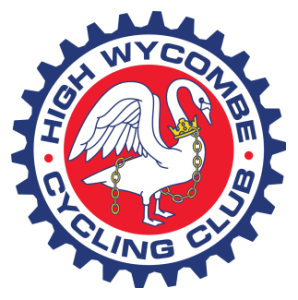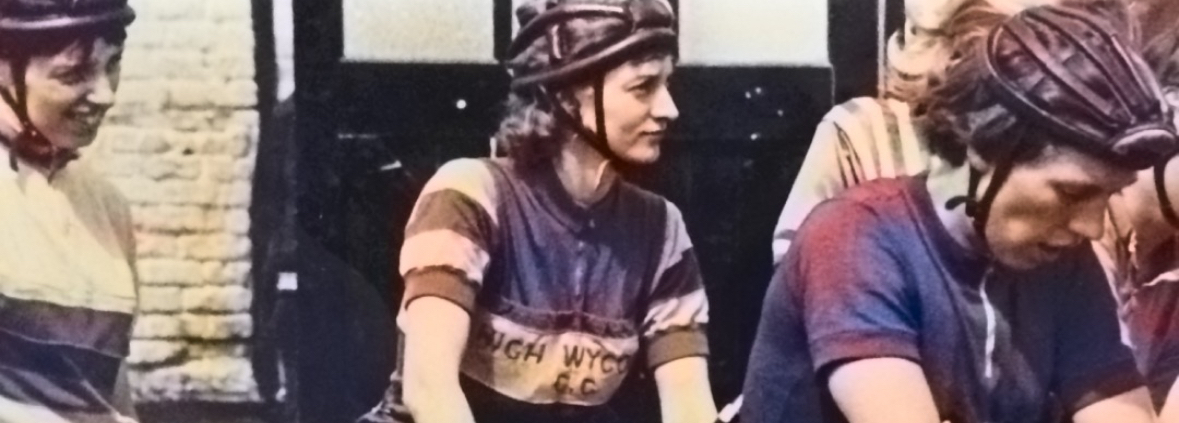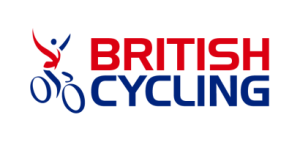1924
The beginnings
Prior to 1924, cycling was very popular in the local area and activity took place in a group known as ‘ The Wycombe Wheelers’ from as early as 1894. It is reported that during celebrations held on the Rye for a cyclist named George Dole, he rode around the arena playing the flute!
The First World War put an end to cycling club activities, but post war years saw renewed activity until it became clear that a properly organised and constituted club was warranted. Some active members at that time were Dick Piggott, Ernie Saunders, Cliff Hoing, Mick Fryer, Perce Gantzel (Captain), A.Ing, Ron Dowdy, Sid Busby, Bill Smith and Jim Smith. Frank Thorne was a sign writer who designed the club badge incorporating the swan so closely associated with High Wycombe and Buckinghamshire. In those days the 25-mile Time Trail course started at the bottom of Hammersley lane in High Wycombe and turned on the canal bridge at Uxbridge. In 1925 Les Stone won the event with a time of 1hr 16mins and Mick Fryer won 1st handicap in 1hr 18mins.
But cycling life was not all racing; in fact it was almost incidental to the main ideal of living for cycling in all its aspects. The social life was a much more prominent aspect in those days. Dances were held every Tuesday evening and the Club even provided its own band. Club night was Thursdays when members would ride to the “Prince of Wales” at Wycombe Marsh. Cyclist Touring Club meetings were held at Slough on Wednesdays and Wycombe members would ride over to join in the activities. Club runs at the weekends were very popular and often numbered as many as 50 or 60 riders. The police would often insist that the groups of happy cyclists be split up into groups of 20 to avoid traffic problems. A rendezvous at a distant tea shop would be agreed where the riders would meet to fortify themselves, exchange news, and generally enjoy the bonhomie and comradeship resulting from common interests and enthusiasm.
Cycling was a way of life. Summer camps, club tours to Kent, The Wye Valley, Wales, Devon and Cornwall and all on bikes which when stripped of saddle bag and mudguards would be used for racing on grass track and road alike. Other favourite jaunts were the night ride to Cheddar Gorge, weekends in Cotswold’s and rides to the “Swan” at Burford where bed and breakfast was 4s.6d. Prodigious miles were covered when touring. Typical of this was the tour undertaken by two leading club members, Les Stone and Perce Gantzel who when riding in Lancashire met two lassies from Wigan also a wheel. A friendship was struck and from then on both lads continued courting by riding to Wigan every Friday and returning on the Sunday, arriving home just in time for work. Eventually wedding bells rang when the fittest grooms ever to walk up the aisle married their Lancashire lassies.
In 1927 the club became affiliated to the national cycling organisations and the club flourished. One or two member’s names began to appear in “Cycling” magazine, which in those days was 50 pages thick. Les Chown was one of the country’s top time triallists at the time, Cliff Hoing excelled in grass track events held at fetes which included athletics, flower shows and the like.
1930-1940
The 1930’s were significant in the club’s history and Tandem racing became popular with several successes achieved.
Caswell and Pickup broke the national tandem tricycle London to Brighton and back record. Les Chown won the Oxford city 50 in 2hrs 12mins 57secs. and Jack Pearson won the National cyclist union (NCU) 5 mile grass track championship at Reading during the whit Monday meeting.
In 1934 Sid Busby and Jack Pearson broke the club 25-mile record in 55mins and 18secs. Great rivalry existed between clubs and riders. Other prominent tandem riders around at this time were Cyril Martin, Ken Deadman, Lipscombe and Stockdale. Wycombe riders also won the Archer Tandem ‘50’ award. Massed start road racing on public roads was illegal at this time and events had to be held on privately owned grounds such as Brooklands, Donnington Park, Thruxton and Woodstock. In 1935 High Wycombe rider, Jack Pearson, took part in a massed start race at Brooklands during which he was involved in one of the biggest cycling crashes ever, being carried off the track unconscious and suffering multiple injuries.
The war in 1939 suspended all club activities and the cups and trophies were put away in the vaults of the Bank. Those riders remaining still carried on riding whenever possible and formed a “skeleton” committee to keep things ticking over. Newsletters were sent to members in the forces to keep them posted of local events and club activities. After the war the club got together again and there was an influx of new young members. Les Strange won the Berks, and Oxon 25 mile Time Trail championship. Became a leading rider in the area and broke Les Chown’s 17 year old club ‘50’ record with a time of 2hrs 9mins 43secs.
1950-1960
In the early 1950’s, the main club organisers were Don Hill. Dennis Keen, Paul Burnett, Derek Hoskins and Derek Rollins.
The Club boasted a prominent lady rider in Betty Older. She held all the ladies’ records, which were to last for the next 10 years. Another lady rider of that era was Janet Scott who was a close rival of Betty Older. In 1959, Junior rider, Colin Hughes became the first Wycombe member to beat the hour mark for a 25 mile with a time of 59mins and 48Secs and John Barnes was club champion.
The Weekly club meetings were held at West Wycombe Methodist Hall and Club activities flourished. By the late 1950’s the club had gone from strength to strength. All day club runs were the central activity with stops for dinner and tea. As many as 30 riders would assemble and racing members would join the run at teatime. The weekly club meetings moved to the Saracens Head in Green street, High Wycombe, John Willson became club secretary and founder members children started taking an active part. Jack Pearson’s daughters, Sue and Janet and Mick Fryers daughter, Helen comes readily to mind.
1960-1970
Some Stalwarts of the Club at this time were Trevor Gilbert, Colin Key and Harry Wheat.
John Baldwin became Club Champion in 1960, breaking Club records for 10, 20, 25 and 30-mile time trials. In the early 1960’s membership numbered about 40 and the club was very much socially biased. However, time trialling was becoming more prominent and one or two riders were trying their hands at road racing. During this period racing started to play an increasing part in Club activities and some useful riders started to emerge. John Johnson was Club Champion in 1962 and 1963, breaking Club records for the 50, 100 mile and 12-hour time trials. Junior riders, John Harvey, Mark Carritt and Tony Low were prominent in road racing, winning many team and individual prizes. John went on to win the Divisional Championship and ride in the National Championship in 1964.
In 1963 a young lady, who was to play a leading role in the club in subsequent years, started racing, winning honours in Club, Open and National Time Trial events. This was Margaret King, who continued hitting the headlines regularly as Margaret Wright. Ladies club records, which had stood for ten years, started falling to Margaret. The Club 15-mile time trial was a typical success story. When Margaret broke the club record, in a time of in 38mins 55secs, she was only 55secs slower than the national record at that time. She went on to break club records in 10, 15, 25, 30, 50 and 100-mile time trials.
To celebrate the 40th Anniversary, in 1964 the club promoted the Ladies National Road Race; a considerable success for the Club at the time. Margaret’s husband, Gordon was also riding successfully at this time in time trials and road races. In 1965, together with John Harvey and Mark Carritt, he rode in the Isle of Man International road race for 1st category riders and in 1969 became club champion for the second time. Cliff Grant won the Bucks, Oxon and Berks Senior Road Race Championship and High Wycombe CC won the team prize in that year. Willis Godley won the Junior title and subsequently went on to become a successful senior rider and he turned professional in 1969.
1970-1980
During this period a new young group of riders emerged all showing natural talent and high potential in road racing, time trialling and track racing. These riders were Mick Stacey, Steve Wilson, Jerry Darvill, Chris Glithero and Graham Lacey. Place to place record attempts became popular and Club records for time trials were broken at all distances. In 1971 Steve Wilson broke the Club record for the 25-mile time trial four times eventually setting a fastest time of 55 mins 55secs.
In 1972 the club moving to Downley Village Hall and saw a successful racing season, with. Mick Stacey, Clive Pugh and Steve Wilson rode in the Harp Lager International Grand Prix with Steve just missing a podium placing. He also excelled when he won the classic Charlotteville 50 Mile Time Trial in a very fast time of 1hr 59mins 27secs. High Wycombe CC also took the team prize with Clive Pugh and Dick Oddy making up the team. The Bucks, Oxon and Berks Road Race Championships included Wycombe riders in the honours with Clive Pugh 1st, Steve Wilson 2nd, Mick Stacey 3rd and Steve Noble 5th. Stan Cauvian emerged as an outstanding cyclocross rider gaining many good results for the Club.
In 1973 Ray Bennett broke the Club’s 30-mile time rial record with a very fast 1hr 9mins 50secs. Dick Oddy and Gordon Wright broke the National Road Records Association tandem record for Cardiff to London. Margaret Wright became lady club champion for the 9th time, broke her 30th Club record and came 5th in the Ladies National 100-mile championship. Dick Oddy and Ray Bennett broke the long standing 25-mile tandem club record in 52mins 56secs. Sadly, the club said farewell to Dick and Joan Oddy when they emigrated to New Zealand, complete with tandem. A year later the RTTC recognised Dick’s and Ray’s tandem ‘25’ record as the first to count for the newly instituted National ‘25’ mile competition record for tandems. As a result, Dick Oddy had achieved immortality by putting his name into the national record books for perpetuity.
1974 was one of the worst years remembered as far as the weather was concerned. Incessant high winds and heavy rain adversely affected performances. However, many club members found sufficient form to excel despite the weather. Alan Keating clinched the Club B.A.R championship with his 229.94 mile ride in the South Bucks 12-hour event, coming 5th overall. Margaret Wright again hit the headlines when she placed 5th in the Ladies National ‘25’-mile Time Trial championship in a time of 1hr 4mins 57secs. Later that same year Margaret was again in the national honours when she placed 6th in the Ladies National 100-Mile Championship.
The Club’s concentration on racing continued throughout the 1970s to the extent that one of the country’s top short distance time triallists, Eddie Adkins, was attracted to join the membership in 1976. This wa
s to be brief encounter with the club because Eddie joined the sponsored V.C Slough in 1977. However, in the Wycombe colours, Eddie revised all the short distance club records with 21mins 11secs for the 10, 51mins 49secs for the 25, 1hr 6mins 10secs for the 30 and a staggering 1hr 46mins for the ‘50’. In that same year Eddie was second only to legendary Alf Engers in the Men’s National 25 Mile Championship. Eddie then went on to win the title himself for the next three years but sadly not in Wycombe colours. Many members wondered if any Wycombe member could ever get near Eddie’s club records, yet within a few years two schoolboys were to show the way forward to super times.
Thought the seventies, Steve Noble’s reputation as a road man had gone from strength to strength and in 1978 alone, he won 10 first category road races including the Hexard Grand Prix. In 1979 Steve rode in the Great Britain team in the five stage Sealink International and within two weeks he was off to East Europe where against all odds he finished 70th from 116 starters in the feared Prague, Warsaw, Berlin Peace Race. Acclaimed as the toughest amateur race in the world, this event covered 1600 miles in 16 stages.
In 1979, as Steve Noble continued to make the headlines as a seasoned international, a young schoolboy was emerging who was to set the Wycombe club on an unprecedented record of schoolboy successes. That year saw Peter Keen win the West London Schoolboy’s 10-mile Championship and go on to finish 12th in the National G.H.S 10 Mile Championship at Leicester. The following year Peter achieved 21 minute 10-mile time trials on no less than five occasions and in September became the first Wycombe rider ever to win a national time trial title when he convincingly won the George Herbert Stance 10 Miles Schoolboy Championship in a record time of 21mins 30secs.
1980-1990
In 1981, Richard Clark emulated Peter Keen’s wins in the Thames Valley schoolboy’s championship and the West London 10 mile championship. That year Miles Kingsbury came close to a sub 4 hour 100 mile time trial when he achieved an outstanding victory in the Westerley Road Club’s 100. His time of 4hrs 15secs reduced the long standing 100 record, set back in 1971 by Steve Wilson, by a staggering 11 minutes.
In 1982 Richard Clark, a first year Junior, went on to gain a superb 5th place in the National Junior 25 mile time trail championship in a time of 57mins 24secs. No sooner had Richard moved out of the school ranks than his brother Andrew stepped into his shoes winning the West London schoolboy championship for the fourth successive year by a Wycombe rider. Meanwhile Simon Winfield kept up the Wycombe schoolboy tradition by winning the Thames Valley Schoolboy Circuit Championship at Blenheim Palace.
In 1983 Richard Clark looked an almost certain medalist in the National Junior ‘25’ championship having recorded a new junior club ‘25’ record of 54mins 25secs. In the title race the entire Wycombe team of Clark, David Tyan and Andrew Clark all inexpicably went off course at the same spot during the race!
Later the same year Richard easily won the Welsh Junior ’25’ mile championship in superb 56mins 31secs. Before the year was out he reduced the club’s 10 mile senior and junior record to 21mins 10secs, a near 29mph ride. Richard finished the year in 5th place in the National Junior B.A.R competition with am average speed of almost 27mph. Meanwhile brother Andrew continued the Wycombe tradition and duly won both the west London and Thames Valley schoolboy championship, and then went on to 5th place in the G.H.S national championship in 24mins 27secs. That same year saw Stuart Robinson win the Thames valley junior championship, narrowly outsprinting Richard Clark into second place.
Throughout this period of staggering and unparalleled schoolboy successes Steve Noble continued his dominance in local road races winning the Thames Valley senior road race Championship in 1981 and then again in 1983. In 1981 Steve gained the greatest single day road race performance ever by a Wycombe rider when he finished 4th in the National Senior Road Race Championship in Essex, just 4 seconds behind the winner after 112 miles of gruelling racing.
During the heady days of success in the early 80’s tragedy struck the club in 1982. Lesley Cole was killed whilst riding home one night from a race meeting at Reading Track. The victim of a hit and run accident Lesley’s death left the club membership stunned.
In 1984 Andrew Clark became the first Wycombe rider ever to win a BCF road race medal when he sprinted to 3rd place in the BCF National Schoolboys road race title at Bristol. To many people who witnessed this event and in the commentary that followed in the cycle press, Andrew was the man of the race having towed the breakaway group along for most of the event. Earlier in the year Andrew had convincingly won the West London Championship and the Thames Valley circuit championship’s. Incredibly, for six successive years Wycombe schoolboys had won both championships.
Throughout the late 70’s and through the early 80’s the clubs membership flourished until by 1982 it stood in excess of 100, more than double the active membership back in the mid 70’s period. In consequence the broader aspects of club life began to become prominent again. Tourist trails in the January and February period each year saw massive groups on the road with 50 to 60 riders becoming common on the traditional routes such as the Bicester 50. Unlike the early seventies the summers of the 80’s did not give way solely to racing fraternity and regular club runs were a feature right throughout the year.


